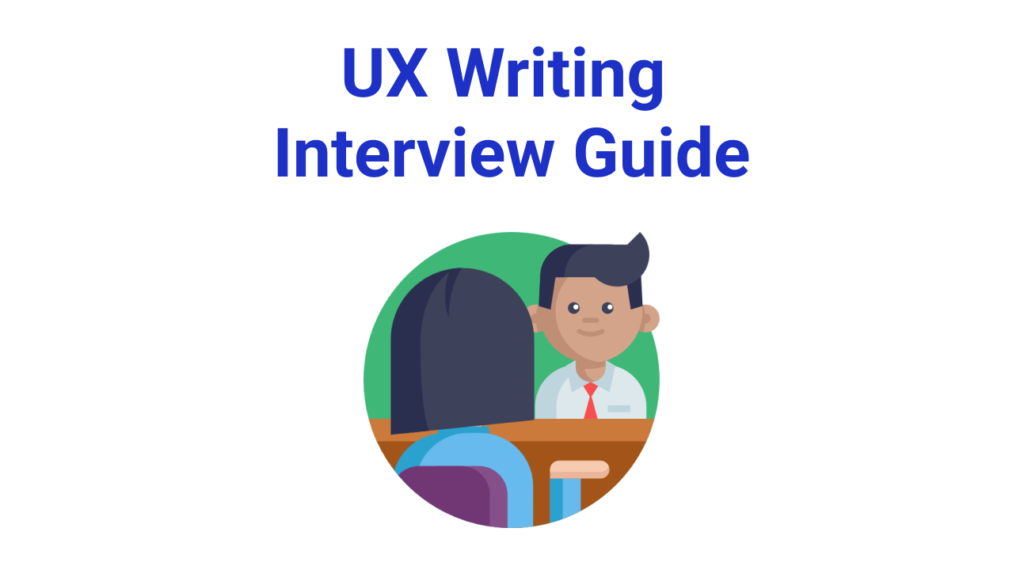Table of Contents
When you’re applying for your first UX writing and content design job, there can be a lot of uncertainty about what to expect in the hiring process. If you’ve moved to the interview stage, congratulations! Here’s a guide to what to expect in the interview process for UX writing jobs.
UX writing interview process roadmap
First, it’s important to know that interviewing for UX writing jobs often involves multiple steps and a home assignment. The exact structure is different at every company, depending on their size and company culture.
You’ll start with a general interview, where you’ll meet with a hiring manager and go over your resume and experience. At this stage, they’re just trying to get a sense of your personality and professional background to make sure that you’re a good fit for the company, not necessarily to check your specific skills.
If you make a good impression during this interview, you’ll be invited back for a second interview which is usually a bit more formal. Expect to receive a UX writing home assignment to evaluate your skills. This is your chance to show your skills, so give it your all!
After you complete the assignment, you’ll have an interview with the design team where they’ll ask you to present your work and explain your process. You might be asked to present your UX writing portfolio at this stage. Some companies hold an additional HR interview and meetings with other teams you’ll be working with as a further step in the screening process.
Finding UX writing jobs and landing an interview
Before you can interview for a UX writing position, you need to find one! While LinkedIn and other professional networking sites can be helpful, submitting resumes isn’t always enough.
Professional networking can take your job search to the next level. If you’re lucky enough to know someone at a company you’re interested in, it’s great to reach out to them and get a referral. Not only does this make it more likely that you’ll be seriously considered for the position, but your friend who referred you may also get rewarded by the company if they hire you, so they’ll be motivated to support your success!
If you don’t know anyone in the company, you can always try reaching out to people on LinkedIn. While many people assume it’s best to message hiring managers, lots of people message hiring managers seeking a job, so it’s harder to stand out.
A better way to get your foot in the door is to message people with mutual friends, or managers in the department you want to work with.
It’s good to ask for advice or start a conversation before directly asking for a referral, and as you build more relationships in the industry, you never know which conversations might lead to your next job!
When identifying positions you want to apply for, you might notice the plethora of titles used for writers in tech. Whether the listing is for a UX writer, content designer, microcopy writer, or UX content professional, don’t worry too much about titles. Instead, focus on the job description.
Sometimes content design roles are in marketing departments, so once you get to the interview stage, it’s important to ask about which team you’ll be working with. (Hopefully, it’ll be the product/design team!)
One great way to find UX writing positions is to join the UX Writing Talent Directory, where companies can find and hire UX writers. You can also check out the UX Writing Hub Job Board, where UX writing and content positions are posted weekly for positions all over the world. Additionally, UX Writing Academy grads can receive personal referrals and assistance throughout their job search process.
Preparing for the interview
To shine in your UX writing job interview, you’ll need to put in a bit of extra work to learn about your potential new company.
First, it’s important to research the company that you’re interviewing with. Learn a bit about the industry they’re in, what distinguishes them from their competitors, and learn everything you can about their current status.
Another step you should take is to use LinkedIn to get a sense of the company’s existing UX writing and design team. Find out if they already have UX writers on staff and how large their design team is. All of this information will help you show your motivation to work with their company and in this industry during the interview.
It’s important to go into your first UX writing interview with confidence. Many new UX writers worry about their perceived lack of experience or feel imposter syndrome because they’re making a career change. Some new UX writers are anxious about not knowing design tools, and while it’s helpful to know the basics of Figma, UX writers aren’t expected to be Figma pros.
The important thing to remember is that no matter what past experience you have, your perspective has value. Ask yourself how the experiences on your resume informed your thinking about user experience.
For example, if you have experience as a teacher, you can discuss your experience designing lesson plans and homework for your students as part of your user experience background. Whatever your background, there’s a way to show prospective employers how it informs your process as a UX writer.
If you’re enrolled in the UX Writing Academy or Flex Program, you can schedule a one-on-one meeting with your UX writing mentor to help you prepare for the interview and learn how to best position your unique experience and skills.
What to say and ask in the interview
When you get to the interview, the most important thing to do, cliche as it is, is to be yourself! Be honest and transparent, and focus on your experience level. It’s great to talk about what led you to UX writing—employers want to understand why you’re coming to this new field. Show your passion and the impact you can make on the company!
If you’ve done a UX writing course or boot camp before, you can talk about what you learned in that course. Students of the UX Writing Academy can share their experience working on a real UX writing project, and get personal advice from their UX writing mentors on how to best showcase their experience to prospective employers.
Aside from putting your best foot forward, you should also ask questions to get a sense of the work environment you’ll be joining. Is the position a fast-paced hustle where you’ll be working all the time, or a more traditional 9–5 position? Will you be working from home or from the office? What product will you work on?
Here are some questions you might want to ask:
- What product(s) would I work on?
- Why are you looking for a UX writer now?
- What is the managing style like?
- How do you see a UX writer integrating with your team?
Asking these questions will help you get a sense of what your day-to-day life will look like working for this company. Some companies need to be taught how to integrate a UX writer into the design team, and it’s important to know how they envision your role before you begin so that you can advocate for UX writing in the company after you land the job.
Portfolio and UX writing home assignments
Many UX writing positions request a portfolio submission. If you’re still in a UX writing course or busy with work and don’t have it ready, it’s OK to ask for more time to prepare your portfolio. Or, consider putting together a simple slide deck showcasing your work. This can be a quick win while also allowing you to tweak things for a particular company/position.
Some candidates have found success directly asking for the home assignment instead of submitting a portfolio, but this is a bold move.
For the take-home assignment, you’ll be given a problem statement or some screens to review the copy on. You’ll likely have up to a week to complete the assignment.
Just like with your portfolio, you should be ready to present your work along with your process. This is your opportunity to show your knowledge of UX and how user-centered your decisions are. This can differentiate you as a candidate, showing your readiness to join a product team.
Similarly, in your portfolio review, it’s beneficial to show your knowledge of UX research and UX design. If you worked with a team in any of your portfolio projects, share that process when you present your work. If you have data to back up the impact of your work, it’s great to bring that to the table as well.
After the interview
After you’ve made it through the last interview stage, the only thing left is to wait to hear if you got the job!
It’s important to keep in mind that each job is different, and if one position doesn’t turn out to be a good match for you, there’s a growing market for UX writers and content designers. Each time you interview, it will help you practice and bring you one step closer to landing the UX writing job of your dreams. Good luck!



